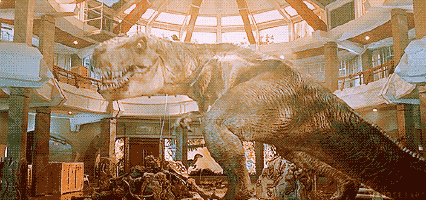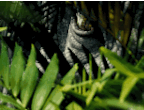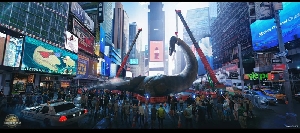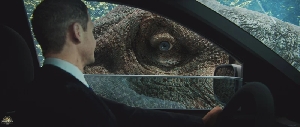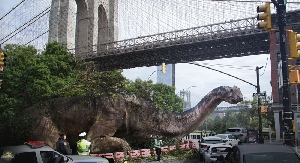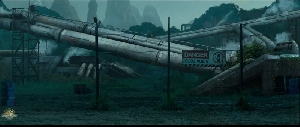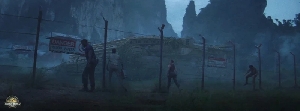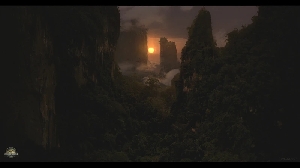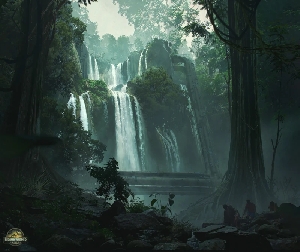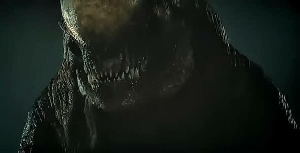Tyrannosaur feeding traces on Deinocheirus (Theropoda:?Ornithomimosauria) remains from the Nemegt Formation (Late Cretac
Dinosaurs Forum Topic

Carnosaur
MemberCompsognathusMar 6, 20152239 Views14 Replieshas any one read Tyrannosaur feeding traces on Deinocheirus (Theropoda:?Ornithomimosauria) remains from the Nemegt Formation (Late Cretaceous), Mongolia (Bell et. al 2012)?
Just me?
well, anyway, you can look it up if you feel so inclined, it's a readily available paper.
I'll post some interesting sections, and y'all can leave your thoughts on it :D
In 2008, members of the Korea-Mongolia International Dinosaur Project relocated and reopened the holotype quarry of D. mirificus. Systematic examination of the quarry and spoil piles left from the original excavation, uncovered hundreds of bone fragments and several nearly complete gastralia. Visual inspection of the newlycollected material for evidence of biomodification led to the discovery of several bite marks on two gastralia fragments. Tanke and Currie (2000) subdivided tooth marks into five categories: (1) punctures; (2) gouges, scores, or tooth drag marks; (3) small-scale parallel striae; (4) combinations of the aforementioned categories; and (5) embedded teeth or tooth fragments. Types 3 and 5 are important as they often permit identification of the animal responsible for the bite; however, specimens in the latter category are exceedingly rare (Currie and Jacobsen, 1995; Jacobsen, 1998; Buffetaut et al., 2004; Bell and Currie, 2010; Xing et al., 2012). Small-scale parallel striae (type 3; Tanke and Currie, 2000) are produced when the serrated edge of the tooth is dragged across the surface of the bone leaving an impression of the denticles. The resulting impressions can be matched to the teeth of particular theropods based on size, shape, and spacing of the grooves (Jacobsen, 1995, 1998). Although bite marks are not uncommon in the fossil record, tooth-marked theropod bone is particularly rare, constituting approximately 2% of theropod feeding traces (Jacobsen, 2001). Bite marks are particularly notable on the bones of Deinocheirus as they offer insight into the diet of Nemegt tyrannosaurs and the taphonomy of the only known specimen of this exceptionally rare and enigmatic species."
- Description of bite marks
"Two gastralia fragments (MPC-D 100/126) recovered from the holotype quarry of Deinocheirus mirificus preserve parallel striae and score marks. The bones themselves are gently bowed, subcircular to elliptical in cross-section but otherwise featureless.* One fragment is 62 mm in length and shows distinct small-scale parallel striae (type 3 markings of Tanke and Currie, 2000) that extend for half of the length of the specimen (Fig. 2A). Individual striae are broadly U-shaped in cross-section and measure 0.5 mm in diameter. At one end of the bone fragment, a series of five parallel striae form a gentle arc approximately 4 mm long. Immediately adjacent to this, a series of 7e10 parallel striae extend approximately 11 mm oblique to the long axis of the element. The latter grouping of striae are separated by a strip of unmarked bone (1 mm wide) from a second set of seven parallel striae that extend approximately 15 mm in length (Fig. 2B). The striae of both groups are parallel to one another. A second gastralia fragment measuring 74 mm in length (Fig. 2C, D) preserves three score marks (type 2 of Tanke and Currie, 2000) transverse to the long axis. Two occur at about the midpoint of the element; the largest mark is 5.5 mm long and up to 1.2 mm in diameter and is an uneven V-shape in cross-section. The second mark is shallower and less well-defined than the first, and measures 3.5 mm long. A third score measuring 3.4 mm long is preserved at one end on the opposite face of the gastralia"
* having observed these bite marks before ever coming across these papers, i suspected that they were evident of tyrannosaur bites -- hence the semi elliptical cross sections. At least to me, that equalled a dead give away. I went to school with a guy that thought they were made by a large undescribed megalosaurid (lol)
-Discussion
"The large size (2 D p/2 mm) and U-shaped cross-section of the denticle scours on MPC-D 100/126 most closely matches the maxillary and dentary teeth of tyrannosaurs (Currie et al., 1990; Abler, 1992; Hurum and Sabath, 2003). Denticle counts are too small to match those of known dromaeosaur, therizinosaur, and troodontid teeth from the Nemegt Formation. Denticle basal lengths of 0.5 mm are only seen in tyrannosaurids (including Tarbosaurus) and the North American troodontid, Troodon (Farlow et al., 1991); however, the U-shaped morphology of the grooves is inconsistent with the V-shaped marked produced by troodontids (Jacobsen, 1998). Moreover, Zanabazar, the only well-known troodontid from the Nemegt Formation, has a denticle count approaching twice that of Troodon and the denticle scours on MPCD 100/126. Farlow et al. (1991), who included Tarbosaurus in their study of theropod teeth, observed that serration size increases linearly with tooth size among theropod dinosaurs. Assuming the type 3 marks on MPC-D 100/126 were made by denticles on the posterior (distal) carina, we can use the regression, serration basal length ¼ [0.0119 * FABL] þ 0.187, given by Farlow et al. (1991) to estimate the fore-aft basal length (FABL) of theropod teeth (exclusive of Troodon and Spinosaurus). From this, we determine the FABL of the tooth that delivered the bite on MPC-D 100/126 to be 26.3 mm. Alternatively, if the marks were created by denticles on the anterior (mesial) carina, using the regression, serration basal length ¼ [0.0150 * FABL] þ 0.126, we determine the FABL to be 24.9 mm. The estimated large size of the tooth responsible for the marks on MPC-D 100/126 is representative only of tyrannosaurids. Among Nemegt tyrannosauroids, only Tarbosaurus bataar has teeth that match these dimensions. The relatively small size of the dentary teeth of Bagaraatan (max. FABL ¼ 9 mm; Osmólska, 1996) and Alioramus (max. FABL ¼ 18 mm; Brusatte et al., 2012), disagree with the larger values obtained for MPC-D 100/126. The taxonomic assignment of type 2 marks on the larger gastralia fragment are more ambiguous; however, type 3 bite marks described here can be confidently assigned to Tarbosaurus. Although no systematic study has been carried out on theropod bite marks on the bones of Nemegt dinosaur fauna (see Jacobsen, 1998, for a North American example), large theropod (presumably Tarbosaurus) bite marks are not uncommon on isolated hadrosaur and sauropod elements from that formation (PB, pers. obs.); however, tooth-marked theropod bone is exceedingly rare (2% of tooth-marked bone is theropod from the Dinosaur Park Formation; Jacobsen, 2001). MPC-D 100/126 therefore captures an exceptional moment of behaviour and interaction between the largest predator and one of the rarest species in the Nemegt ecosystem. Based on the absence of reactive bone growth on the gastralia (that would be suggestive of healing), the bites took place post-mortem (or perhaps less likely, peri-mortem) and are therefore indicative of scavenging/feeding behaviour rather than an interspecific display of aggression (Tanke and Currie, 2000; Bell and Currie, 2010). The inclusion of large theropods such as Deinocheirus in the diet of Tarbosaurus is consistent with the diverse and opportunistic diet seen in North American tyrannosaurs (Chin et al., 1998; Jacobsen, 1998, 2001; Varricchio, 2001). Indeed, evidence suggests that tyrannosaurs were capable of cannibalism (Longrich et al., 2010). Although we were not able to inspect visually the holotype (ZPAL MgD-I/6), Osmólska and Roniewicz (1970) did not note bite marks on the pectoral girdle, forelimbs or vertebrae they described. Based on the available material, bite marks reported here on the gastralia suggest bites were focused around the gut, perhaps to gain access to the viscera as is common with extant mammalian carnivores (Haynes, 1982; Blumenschine, 1986). Similarly, given the location of the bites on the ventral underside of the body, it is most likely that the bites took place after the animal was lying prone as would be expected of bites inflicted during feeding (Blumenschine, 1986). The disarticulated state of the skeleton (Osmólska and Roniewicz, 1970, fig. 1) and the presence of bite marks on at least two gastralia further suggest that scavenging/ feeding by one or more Tarbosaurus played a role in dismemberment of the giant carcass of the only known specimen of Deinochierus."
Do note that these findings were before we had what we do of D. mirificus now.
if you are not familiar with these new findings, or you just relied on the media reporting on it to figure out what the bloody hell deinocheirus actually was, i'll leave a citation below, as well as some of my own thoughts on tarbosaurus predation on this bizarre creature.
oh, and also the description of the material that was discovered in 2014, cuz you know that may or may not be of interest.
- Description
"Bivariate comparisons of the skull (1024 mm from premaxilla to occipital condyle)*with thefemur show that the cranium (Fig. 2) is low and narrow like other ornithomimosaurs, but that the antorbital region is more elongate than in other members of this clade. The premaxillae and dentaries expand anterolaterally to form a spatulate beak; the external nares open dorsally. In lateral view, the buccal edges of the premaxilla, maxilla and dentary slope anteroventrally. Pitting of the anterior surfaces indicates the presence of keratinous rhamphotheca in life. The nasal is a narrow strap-like bone extending from the anterior third of the internarial bar to above the orbits. Similar to Gallimimus, the jugal and quadratojugal form an extensive posteroventral lobe that closed off the lower part of the infratemporal fenestra . The pneumatic fossa of the quadrate is particularly large, about 30% the height of the bone. The outside diameter of the sclerotic ring (84 mm) is relatively small compared with skull length (Extended Data Fig. 1), which suggests that Deinocheirus was probably diurnal6 . The edentulous lower jaw is strikingly massive and deep in lateral view in comparison with the slender, low edentulous maxilla. It scales with tyrannosaurids in the depth of the jaw, rather than ornithomimids Each of the ten cervical vertebrae is low and long. Posteriorly the centra become progressively shorter and more trapezoidal in outline; this produces a more strongly S-curved neck (to support the relatively larger skull) than in other ornithomimosaurs. Twelve dorsal vertebrae have distinctive configurations; the neural spines of anterior dorsals are low, but increase progressively to that of the last dorsal, which is 8.5 times taller than its centrum height; it almost attains the highest ratio of Spinosaurus. Because of the presence of an intricate system of interspinous ligaments, they were probably specialized to support the abdomen from the hips and hind limbs in a manner similar to an asymmetrical cable-stayed bridge. The elongate spines might also have served in display. Dorsal vertebrae have numerous laminae forming basal webbing with associated fossae, and the degree of pneumaticity is comparable with that of a sauropod. All six sacral neural spines are tall and highly pneumatic, extending up to 170% of ilium height. Except for the first sacral, the tops of the sacral neural spines are fused into a midline plate of bone, the dorsal margin of which is straight in lateral view. An accessory spinodiapophyseal lamina is developed anterior to the spinodiapophyseal lamina in each of the third to fifth sacrals. These two laminae meet at the diapophysis to form a unique V-shape in lateral view (Fig. 3). The first caudal neural spine curves anteriorly in lateral view, and is distinctly shorter than that of the final sacral. The tall anterior caudal neural spines have strong anterior and posterior rugosities with many small foramina for the interarcual ligaments. The end of the tail is represented by at least two vertebrae that were fused together as in oviraptorosaur and therizinosauroid pygostyles8,9. The presence of a pygostyle suggests the possibility that ornithomimosaurs, which are known to have pennaceous feathers10, also had fans of feathers at the ends of their tails for display purposes11. Honeycombed camellate pneumatic systems are present in all Deinocheirus vertebrae except for the atlas and the distal caudals. Camellate internal structure is also in the parts of the ilium, pubis and ischium that are adjacent to the sacrals. Vertebral pneumaticity correlates with gigantism12. A U-shaped furcula with a hypocleidium was recovered for the first time in ornithomimosaurs. The triangular acromial process of the capulocoracoid prominently projects at an angle of about 50ufrom the scapular blade. This feature cannot be seen in the holotype due to damage. The ilium appears distinctive because regions of the typical ornithomimosaur pelvis are hypertrophied to support the animal’s great weight. The rounded preacetabular ala is taller but anteroposteriorly shorter than the postacetabular ala, which has a concave dorsal margin. The robust supraacetabular crest overhangs the anterodorsal margin of the acetabulum; because the crest was normally directly above the head of the femur, the ilium was tilted posteroventrally in life. The ischium is as long as the pubis. Thefemur is longer than the tibia, as expectedfor such a large animal13. In dorsal view, the medial edge of thefemoral head has a prominent hook on the posteromedial corner, and a dome-like tubercle on the anterior edge that has never been reported, to our knowledge, in any other dinosaur. Thefemoral head is twisted 15u anteromedially to thefemoral shaft. The robust cnemial crest of the tibia projects above the level of the proximal articular surface as inBeishanlong14 andGarudimimus15. The baseline condition of a relatively short, non-arctometatarsalian metatarsus is present as inmost other theropods16. However, the outline of the proximal end of the third metatarsal in Deinocheirus is quadrangular, rather than triangular as in basal ornithomimosaurs. The foot is as short in the relative lengths of digit III to metatarsal III as it is in Garudimimus. Each pedal ungual has a unique shape that has never been reported, to our knowledge, in any other theropod dinosaur, with the distal end bluntly truncated rather than tapered (Extended Data Fig. 5). Deinocheirus was coded into a theropod data matrix that incorporated a comprehensive analysisfor Ornithomimosauria17 (Extended Data Fig. 6). It was recovered as a sister taxon of Garudimimus within the Ornithomimosauria (Fig. 4). This comprehensive phylogeny suggests that basal ornithomimosaurs separated into two lineages (Deinocheiridae and Ornithomimidae) in the EarlyCretaceous. The Deinocheiridae consists ofDeinocheirus,Garudimimus, and the older Beishanlong.Deinocheirus (MPC-D 100/127) had a body length of 11 m and an estimated body weight of 6,358 kg, and is the largest known ornithomimosaur"
* 1024mm translates to roughly 3.3ft long, it is indeed a large skulled ornithomimian.
Clicky clicky here for the paper:
https://geology.kangwon.ac.kr:40864/korean/files/______-36_5___.pdf
Now, onto predation by T. bataar.
According to this new information, D. mirificus would weigh ~6.6 tons. While elsewhere on this forum i've shown that the largest T. bataar specimens were in the 4 - 4.5 ton range. Tyrannosaurids were thought to be capable of taking large, "dangerous" prey animals, so keeping this in mind. here's a section from Bell et a.(2012)
"Based on the available material, bite marks reported here on the gastralia suggest bites were focused around the gut, perhaps to gain access to the viscera as is common with extant mammalian carnivores (Haynes, 1982; Blumenschine, 1986). Similarly, given the location of the bites on the ventral underside of the body, it is most likely that the bites took place after the animal was lying prone as would be expected of bites inflicted during feeding (Blumenschine, 1986). The disarticulated state of the skeleton (Osmólska and Roniewicz, 1970, fig. 1) and the presence of bite marks on at least two gastralia further suggest that scavenging/ feeding by one or more Tarbosaurus played a role in dismemberment of the giant carcass of the only known specimen of Deinochierus."
This doesn't necessarily mean the Tyrannosaur killed the ornithomimian, but simply the bite marks left on gastralia were made after the animal had fallen. So, two things are (obviously) likely
- The giant theropod was dead and had been scavenged by the tyrannosaur
- Ambush had been deployed, and the tyrannosaur was sucessful in predation
one thing is certain now, though, Deinocheirus was on the menu of the big asian tyrannosaur.
Do you think Tarbosaurus was capable of taking down fully grown Deinocheirus? or do you think it could only take smaller, immature ones?
leave your thoughts down below!
Nature doesn't deceive us; it is we who deceive ourselves.
Replies to Tyrannosaur feeding traces on Deinocheirus (Theropoda:?Ornithomimosauria) remains from the Nemegt Formation (Late Cretac
Hey Guest, want to add your say?
Are you an avid Jurassic World fan looking for a dedicated online community of likeminded fans? Look no further! Create your own profile today and take part in our forums and gain XP points for all the content you post!




